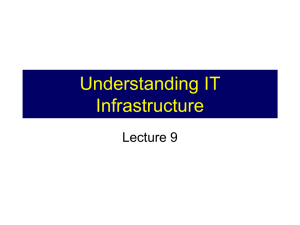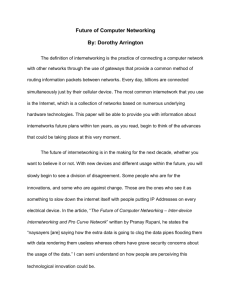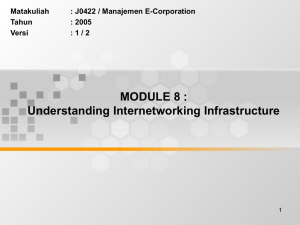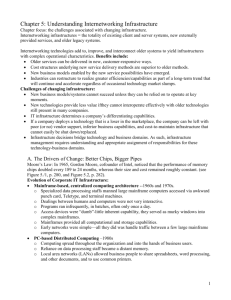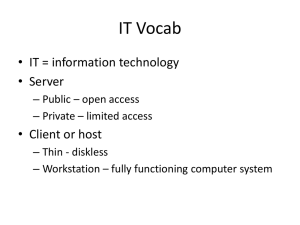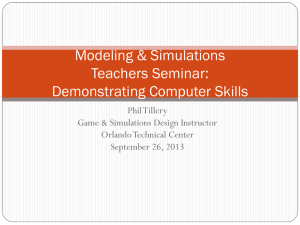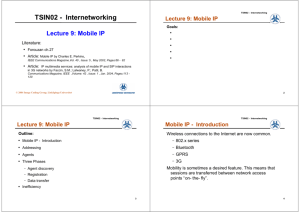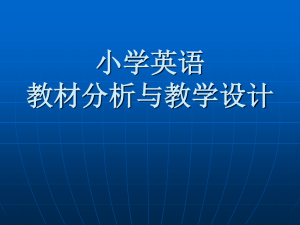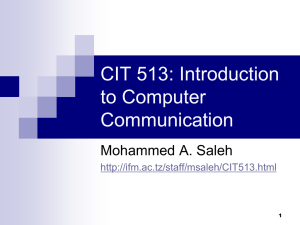Understanding Internetworking Infrastructure
advertisement
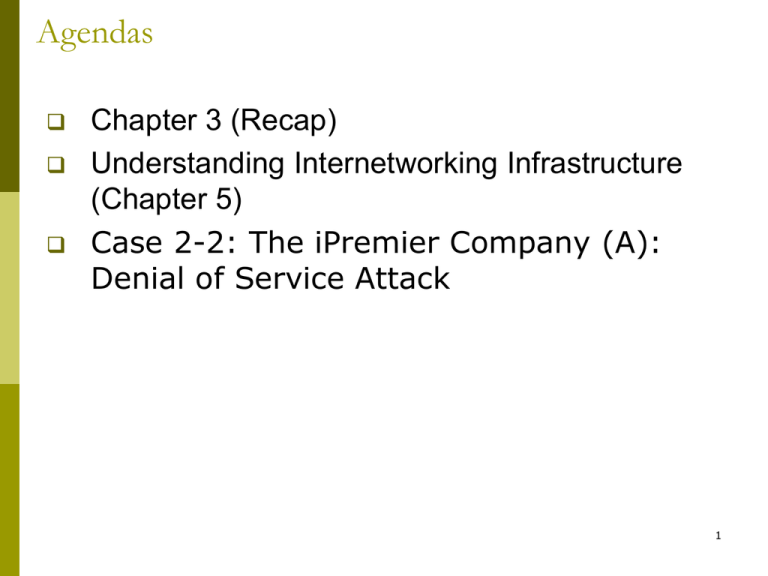
Agendas Chapter 3 (Recap) Understanding Internetworking Infrastructure (Chapter 5) Case 2-2: The iPremier Company (A): Denial of Service Attack 1 Three Inter-organizational Governance Models (Recap) What are the three governance models? Describe each governance model. Three Inter-organizational Governance Models Market Hierarchy Simple exchange of goods, services, and payments, usually during a specific time period and with limited interaction or information sharing between the parties involved Formal contracts and authority define the activities to be performed, the products or services to be provided, the price to be paid by each party, and the length of the relationship Partnership Require shared goals, complementary expertise and skills, high levels of trust among the parties, and networked integration of processes and work across organizational boundaries Three Network Ownerships What are the three types of ownerships? Describe each network ownership. Three Network Ownerships (Recap) The majority of specialized units may be located inside a corporation or other legally defined organization. An alliance may be formed between two ( or a small number of players). A diverse community, also called an ecosystem, of players representing different roles (e.g., suppliers, distributors, buyers) may work together to achieve shared goals. Governance and Ownership Ownership Community Alliance Corporation Hierarchy Market Partnership Governance 6 Course Road Map ISQS 5231 Business Impacts Networked Infrastructure and Operations Making Case for IT Internetworking Infrastructure IT and Strategy Diverse IT Infrastructures IT and Organization Reliable and Secure IT Services Extending the Enterprise Leadership Issues Management IT Functions Managing IT Projects Management IT Outsourcing Chapter 5: Understanding Internetworking Infrastructure Technical issues vs. business issues Bridging the gap between the business and technical domains 8 Chapter 5: Understanding Internetworking Infrastructure Corporate Telecommunications System 9 The IT architecture of an e-business Chapter 5: Understanding Internetworking Infrastructure Moore’s Law 11 Moore’s Law 12 Chapter 5: Understanding Internetworking Infrastructure TCP/IP Evolution of Corporate IT Infrastructure 13 Chapter 5: Understanding Internetworking Infrastructure Metcalfe’s Law 14 Chapter 5: Understanding Internetworking Infrastructure Bandwidth Explosion 15 Components of Internetworking Infrastructure Core technologies Key MGNT Issues Network Fiber optics, cable systems, DSL, Routers, switches, firewalls, software Tech standards Partners Reliability Security Processing Systems Transaction software, servers, server appliances, client services Souring strategy Crisis management Disaster recovery Facilities Corporate data centers, data management Facility selection Reliability Security 16 Components of Internetworking Infrastructure A Simple LAN 17 Network Elements – LAN Local Area Networks (LAN) Connects computers and other digital devices within 2000 ft radius Cabling or wireless technology links computers, network interface cards, and software Network Operating System (NOS) Network Topologies Star, bus, and ring topologies 18 Network Elements – LAN LAN Topologies 19 Network Elements – WAN Wide Area Networks (WAN) Span broad geographic distances Can consist of combination of: Switched lines Dedicated lines Microwave Satellite communications Private WANs expensive to support 20 Network Elements – WAN An Example of WAN 21 Network Elements – MAN Metropolitan Area Network (MAN) Scope between LAN and WAN Limited distance; faster and less expensive than WAN Value-Added Networks Private, third-party managed, data only networks Subscription basis 22 Network Elements – Bridge (Switch), Router, Firewall, Caching Bridge (Switch) Connect network segments at the physical layer Relay and subdividing network device Less or no intelligent in transporting data Router A network device containing software and hardware – usually tailored to the tasks of routing and forwarding information. 23 Network Elements – Bridge (Bridge, Router, Firewall, Cache) Firewall A firewall is a dedicated hardware, or software running on another computer, which inspects network traffic passing through it, and denies or permits passage based on a set of rules. Cache A cache is a block of memory for temporary storage of data likely to be used again. The CPU and hard drive frequently use a cache, as do web browsers and web servers. 24 Elements of Processing Systems Client Devices and Systems Server Devices and Systems Mainframe Devices and Systems Middleware Middleware is the enabling technology of enterprise application integration. It describes a piece of software that connects two or more software applications, allowing them to exchange data. TCP/IP Extremely important Not well-understood 25 Client/Server Computing Client/server computing: Splits processing between “clients” and “servers” on network Powerful personal computers connect to network with one or more server computers Has extended networking to parts of business that could not be served by centralized architecture Processing load balanced over many smaller machines 26 Client/Server Computing Types of Client/Server Computing Client/Server Computing (n-tier) Remote method innovation/Internet Inter-Orb Protocol 29 Packet Switching (How Internet Work) Messages broken into “packets” before transmission Packets include destination and error-checking information Packets travel independently using routers; reassembled into original message at destination Transmission Control Protocol/Internet Protocol (TCP/IP) Open suite of protocols for connectivity developed in 1970s Provides standards for breaking messages into packets, routing them to destination addresses, and reassembling them at end Allows for communication regardless of hardware/software Packet Switching Transmission Control Protocol/Internet Protocol (TCP/IP) TCP/IP: Four-Layer Reference Model 1. 2. 3. 4. Network interface layer: Placing packets on and receiving them from network medium Internet layer: Addressing, routing, packaging data packets Transport layer: Acknowledging and sequencing packets to/from application Application layer: Communication between applications and other layers TCP/IP: Four-Layer Reference Model Complexity and Coupling Complexity Systems have many interactions Interactions can be linear (simple) or complex Linear cause and effect relationships are clear Complex cause and effect relationships are difficult to see or anticipate Coupling Here coupling or dependency is the degree to which each network system relies on each other. Coupling in systems can be tight or loose. Tight coupling changes in A seriously affect B Where System Fall 36 Why Systems Are Vulnerable? Telecommunications networks vulnerabilities Why Systems Are Vulnerable? Type of computer crimes and criminals Hacker: An outside person who has penetrated a computer system, usually with no criminal intent. Cracker: A malicious hacker. Social engineering: Getting around security systems by tricking computer users into revealing sensitive information or gaining unauthorized access privileges. Cybercrimes: Illegal activities executed on the Internet. Identify theft: A criminal (the identity thief) poses as someone else. Cyberwar: War in which a country’s information systems could be paralyzed from a massive attack by destructive software. Virus: Software that can attach itself to (“infect”) other computer programs without the owner of the program being aware of the infection. IS Security and Control Security Treats Method Definition Virus Secret instructions inserted into programs (or data) that are innocently ordinary tasks. The secret instructions may destroy or alter data as well as spread within or between computer systems Worm A program that replicates itself and penetrates a valid computer system. It may spread within a network, penetrating all connected computers. Trojan horse An illegal program, contained within another program, that ‘’sleep' until some specific event occurs then triggers the illegal program to be activated and cause damage. Salami slicing A program designed to siphon off small amounts of money from a number of larger transactions, so the quantity taken is not readily apparent. Super zapping A method of using a utility ‘’zap’’ program that can bypass controls to modify programs or data Trap door A technique that allows for breaking into a program code, making it possible to insert additional instructions. Logic bomb An instruction that triggers a delayed malicious act Denial of services Too many requests for service, which crashes the site Sniffer A program that searches for passwords or content in packet of data as they pass through the Internet Spoofing Faking an e-mail address or web-page to trick users to provide information instructions Password cracker A password that tries to guess passwords (can be very successful) War dialling Programs that automatically dial thousands of telephone numbers in an attempt to identify one authorized to make a connection with a modem, then one can use that connection to break into databases and systems Back doors Invaders to a system create several entry points, even if you discover and close one, they can still get in through others Malicious applets Small Java programs that misuse your computer resource, modify your file, send fake e-mail, etc Protecting the Digital Firm Firewall screening technologies Static packet filtering Network address translation Application proxy filtering Intrusion detection systems Scanning software Monitoring software Security and Electronic Commerce Encryption Authentication Message integrity Digital signatures Digital certificates Public key infrastructure (PKI)

